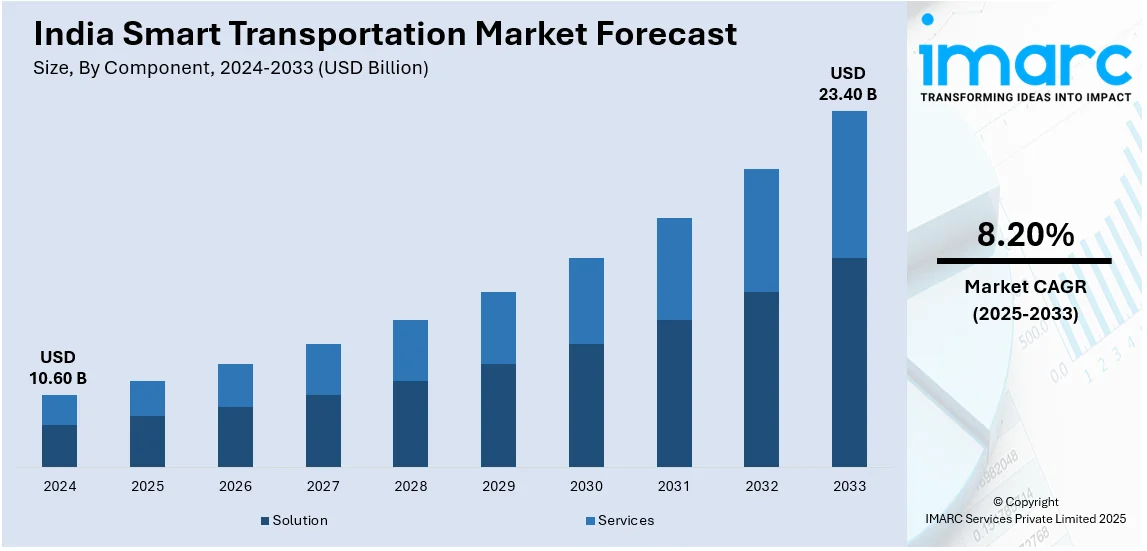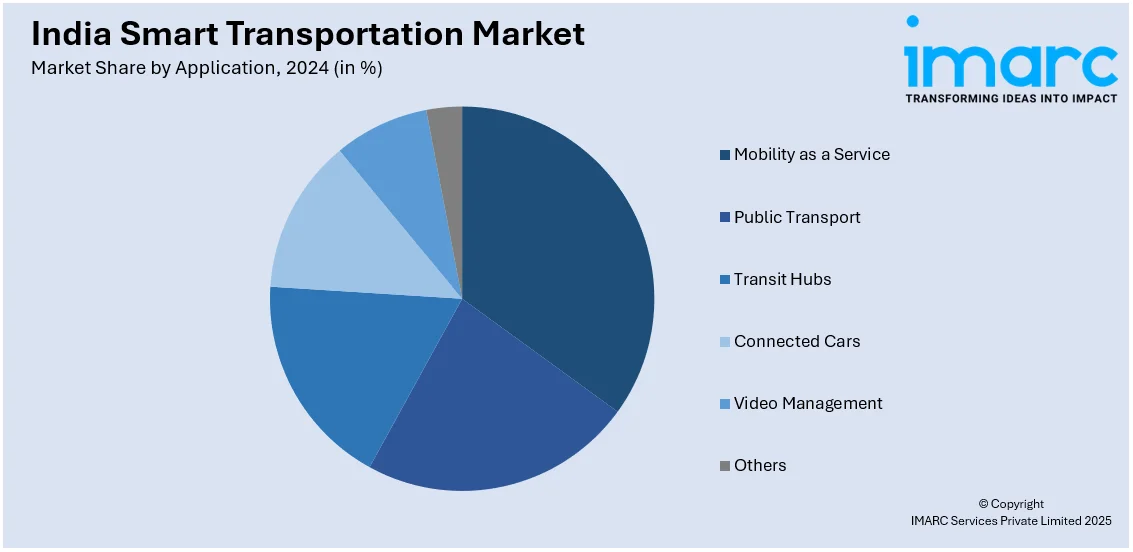
India Smart Transportation Market Size, Share, Trends and Forecast by Component, Transportation Mode, Application, and Region, 2025-2033
India Smart Transportation Market Overview:
The India smart transportation market size reached USD 10.60 Billion in 2024. Looking forward, IMARC Group expects the market to reach USD 23.40 Billion by 2033, exhibiting a growth rate (CAGR) of 8.20% during 2025-2033. Rapid urbanization, increasing demand for efficient public transport, government initiatives for smart cities, advancements in IoT and AI, rising adoption of electric vehicles, improved traffic management solutions, integration of intelligent transport systems, focus on sustainability, development of connected infrastructure, increasing investments in mobility-as-a-service solutions are expanding India smart transportation market share.
|
Report Attribute
|
Key Statistics
|
|---|---|
|
Base Year
|
2024 |
|
Forecast Years
|
2025-2033
|
|
Historical Years
|
2019-2024
|
| Market Size in 2024 | USD 10.60 Billion |
| Market Forecast in 2033 | USD 23.40 Billion |
| Market Growth Rate 2025-2033 | 8.20% |
India Smart Transportation Market Trends:
Growing Adoption of AI and IoT in Smart Transportation
The India smart transportation market growth is driven by the rapid integration of Artificial Intelligence (AI) and the Internet of Things (IoT) to enhance operational efficiency and passenger experience. AI-powered traffic management systems are being deployed to optimize traffic flow, reduce congestion, and minimize travel time. IoT-enabled smart sensors are improving vehicle tracking, predictive maintenance, and automated toll collection. For instance, Karnataka government ordered the installation of the Intelligent Transportation System (ITS) for public cars on January 27, 2025, in accordance with AIS-140 criteria. In order to improve passenger safety and lower occurrences like accidents and thefts, this directive mandates that more than 6.5 lakh vehicles, including taxis, school buses, and public transportation, be outfitted with Vehicle Location Tracking (VLT) devices and emergency panic buttons. Over 40,000 vehicles have been equipped with these AIS-140 compatible devices as of December 31, 2024, and operations are managed by a centralized monitoring center located in the RTO Commissioner Building. With government initiatives such as Smart Cities Mission, investments in intelligent transportation solutions are increasing. The growing demand for real-time traffic data, safety enhancements, and environmental sustainability is further accelerating the adoption of AI and IoT in India's transportation sector.

To get more information on this market, Request Sample
Expansion of Electric and Connected Mobility
The shift toward electric and connected mobility is a major trend in India’s smart transportation market, driven by sustainability goals and technological advancements. The rapid deployment of electric buses, smart charging infrastructure, and vehicle-to-grid connectivity is transforming urban transit. Public and private partnerships are bolstering investments in EV fleets and shared mobility solutions. For instance, a 2025 industry report stated that due to favorable incentives and rising demand, the country's operational electric vehicle (EV) fleet will exceed 28 million units by 2030. It is anticipated that this expansion will result in a considerable demand for energy from the grid, highlighting the significance of sustainability in the country's transportation industry. By 2030, 83% of yearly EV sales will be electric two-wheelers, 10% will be electric four-wheelers, and 7% will be commercial vehicles, such as trucks, buses, and three-wheelers, according to estimates. The rise of 5G connectivity is also enhancing vehicle communication, improving safety, and enabling smart road infrastructure. Government incentives and policies promoting electric and autonomous mobility are accelerating the transition, making smart and sustainable transportation systems a key focus for urban development in India, which in turn is positively impacting the India smart transportation market outlook.
India Smart Transportation Market Segmentation:
IMARC Group provides an analysis of the key trends in each segment of the market, along with forecasts at the country level for 2025-2033. Our report has categorized the market based on component, transportation mode, and application.
Component Insights:
- Solution
- Hybrid Ticketing Management System
- Parking Management and Guidance System
- Integrated Supervision System
- Traffic Management System
- Others
- Services
- Business Services
- Professional Services
- Cloud Services
The report has provided a detailed breakup and analysis of the market based on the component. This includes solution (hybrid ticketing management system, parking management and guidance system, integrated supervision system, traffic management system, and others) and services (business services, professional services and cloud services).
Transportation Mode Insights:
- Roadways
- Railways
- Airways
- Maritime
A detailed breakup and analysis of the market based on the transportation mode have also been provided in the report. This includes roadways, railways, airways, and maritime.
Application Insights:

- Mobility as a Service
- Public Transport
- Transit Hubs
- Connected Cars
- Video Management
- Others
A detailed breakup and analysis of the market based on the application have also been provided in the report. This includes mobility as a service, public transport, transit hubs, connected cars, video management, and others.
Regional Insights:
- North India
- South India
- East India
- West India
The report has also provided a comprehensive analysis of all the major regional markets, which include North India, South India, East India, and West India.
Competitive Landscape:
The market research report has also provided a comprehensive analysis of the competitive landscape. Competitive analysis such as market structure, key player positioning, top winning strategies, competitive dashboard, and company evaluation quadrant has been covered in the report. Also, detailed profiles of all major companies have been provided.
India Smart Transportation Market News:
- 1st March 2025: Tesla, the US electric vehicle giant, has secured a deal to establish its first showroom in India, located in Mumbai's Bandra Kurla Complex, marking a significant step towards its entry into the Indian market.
- 4th April 2024: The Indian Institute of Technology Madras (IIT Madras) launched the 'Mobility and Intelligent Transportation' (MInT) collaborative, aiming to build a global mobility digital infrastructure and an R&D portfolio to develop breakthrough mobility solutions and realize the United Nations' Sustainable Development Goals. It seeks to create a digital platform fostering the "Build for India, Solve for the World" goals, defining mobility as a digital public good and serving as a benchmark for standardizing, developing, and deploying mobility tools and services for everyone.
India Smart Transportation Market Report Coverage:
| Report Features | Details |
|---|---|
| Base Year of the Analysis | 2024 |
| Historical Period | 2019-2024 |
| Forecast Period | 2025-2033 |
| Units | Billion USD |
| Scope of the Report |
Exploration of Historical Trends and Market Outlook, Industry Catalysts and Challenges, Segment-Wise Historical and Future Market Assessment:
|
| Components Covered |
|
| Transportations Covered | Roadways, Railways, Airways, Maritime |
| Applications Covered | Mobility as a Service, Public Transport, Transit Hubs, Connected Cars, Video Management, Others |
| Regions Covered | North India, South India, East India, West India |
| Customization Scope | 10% Free Customization |
| Post-Sale Analyst Support | 10-12 Weeks |
| Delivery Format | PDF and Excel through Email (We can also provide the editable version of the report in PPT/Word format on special request) |
Key Benefits for Stakeholders:
- IMARC’s industry report offers a comprehensive quantitative analysis of various market segments, historical and current market trends, market forecasts, and dynamics of the India smart transportation market from 2019-2033.
- The research report provides the latest information on the market drivers, challenges, and opportunities in the India smart transportation market.
- Porter's five forces analysis assist stakeholders in assessing the impact of new entrants, competitive rivalry, supplier power, buyer power, and the threat of substitution. It helps stakeholders to analyze the level of competition within the India smart transportation industry and its attractiveness.
- Competitive landscape allows stakeholders to understand their competitive environment and provides an insight into the current positions of key players in the market.
Key Questions Answered in This Report
The smart transportation market in India was valued at USD 10.60 Billion in 2024.
The India smart transportation market is projected to exhibit a CAGR of 8.20% during 2025-2033, reaching a value of USD 23.40 Billion by 2033.
The India smart transportation market is driven by rapid urbanization, government focus on smart city initiatives, and the need to reduce traffic congestion and emissions. Advancements in IoT, real-time data analytics, and connected mobility solutions are further enabling intelligent traffic management and efficient public transportation systems across the country.
Need more help?
- Speak to our experienced analysts for insights on the current market scenarios.
- Include additional segments and countries to customize the report as per your requirement.
- Gain an unparalleled competitive advantage in your domain by understanding how to utilize the report and positively impacting your operations and revenue.
- For further assistance, please connect with our analysts.
 Request Customization
Request Customization
 Speak to an Analyst
Speak to an Analyst
 Request Brochure
Request Brochure
 Inquire Before Buying
Inquire Before Buying




.webp)




.webp)












